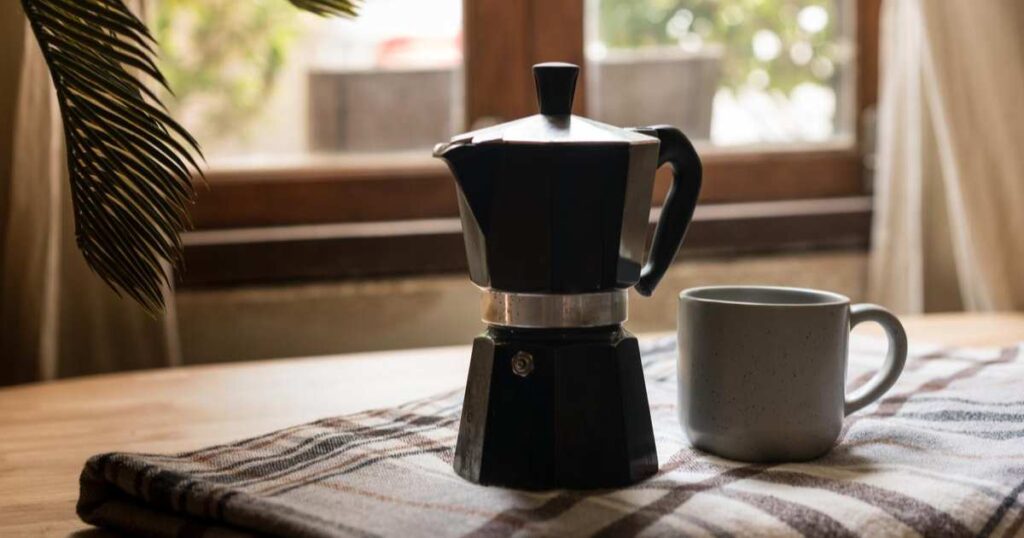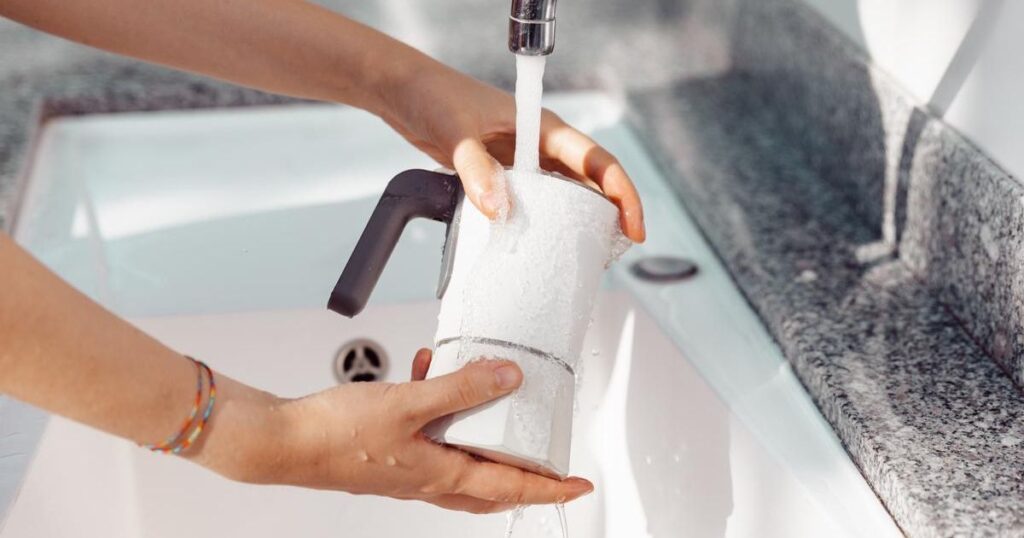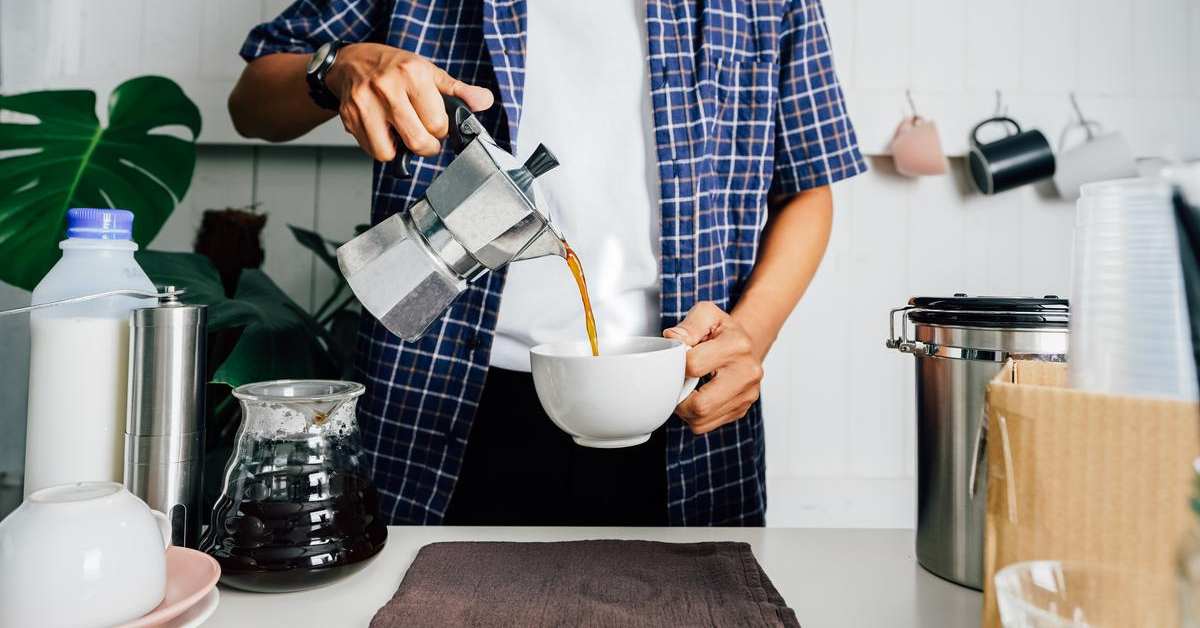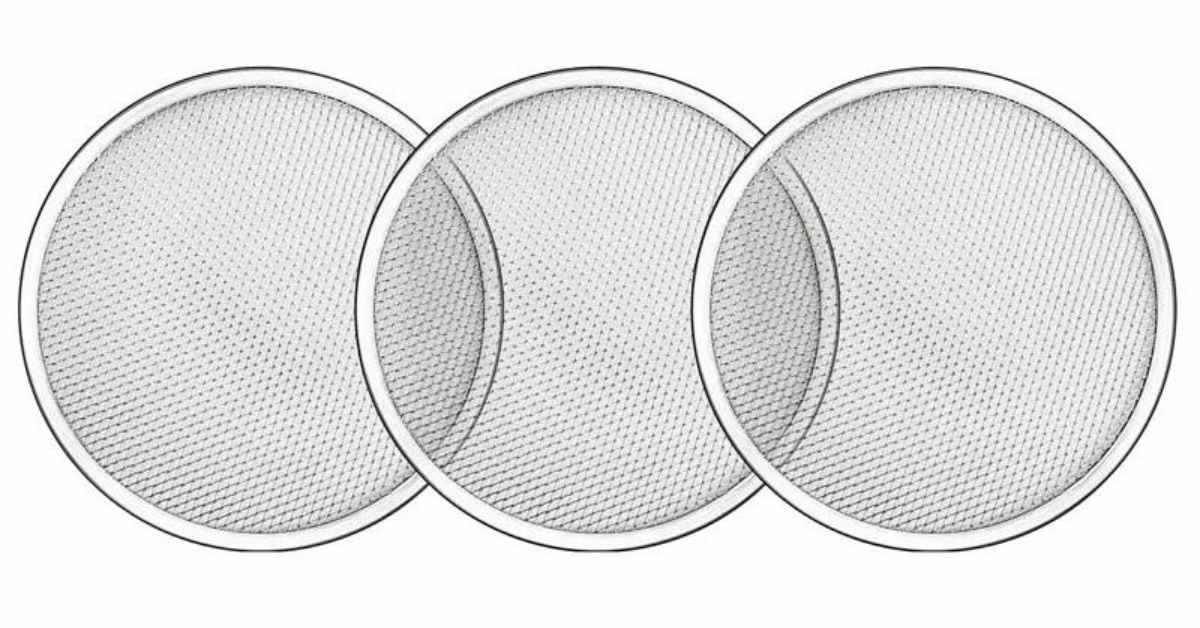Welcome to the delightful world of coffee brewing! If you’re a coffee enthusiast, you’ve probably encountered the Moka pot, a classic stovetop coffee maker that coffee lovers have cherished for generations. The Moka pot, also known as a stovetop espresso maker, produces a rich and robust coffee cup that is perfect for jumpstarting your day.
However, can you put milk in Moka pot? In this article, we’ll explore the possibilities of using a Moka pot with milk and whether creating your favourite coffee beverages is viable. So, let’s dive in and uncover the secrets of this traditional coffee-making marvel!
Table of Contents
ToggleWhat is Moka Pot

Before we delve into the milk and Moka pot combination, let’s first understand what a Moka pot is and how it works. The Moka pot, invented by the Italian engineer Alfonso Bialetti in the 1930s, is a stovetop coffee maker that operates on a simple yet brilliant principle. It consists of three main chambers: the bottom chamber holds water, the middle contains a coffee filter basket, and the top section collects the brewed coffee.
The brewing process is relatively straightforward. As the Moka pot sits on the stove, the water in the bottom chamber heats up, generating steam pressure. This pressure forces the hot water up through the coffee grounds in the filter basket and into the top section, where the magic happens. Due to its rich and concentrated nature, the result is a bold and flavorful coffee with a distinctive aroma, often called stovetop espresso.
Can You Add Milk to Moka Pot
No.
The Simple Answer:
In the traditional Moka pot method, you do not add milk to the coffee-making process. The Moka pot is designed to brew intense and concentrated coffee by passing hot water through coffee grounds. While you can enjoy the resulting coffee in various ways, such as adding hot water to make an Americano or mixing it with hot milk to create a Moka coffee-like drink, the milk is not added directly to the Moka pot during brewing.
If you prefer your coffee with milk or enjoy espresso-based drinks like lattes or cappuccinos, you can make the coffee using the Moka pot and then add the milk separately. You can adjust the coffee-to-milk ratio according to your taste preferences. So, even though you cannot add milk to the Moka pot, you can still enjoy a creamy and delicious coffee by combining it with milk afterwards.
Pros and Cons of Adding Milk to Moka Pot
Pros of Adding Milk to Moka Pot
Convenience: One of the primary advantages of adding milk directly to the Moka pot is convenience. Combining the milk with the coffee during brewing saves time and effort; you won’t need to heat the milk separately.
Creamy Texture: Mixing milk with the coffee in the Moka pot can result in a creamy and velvety texture. Combining the bold Moka coffee and the smoothness of milk creates a delightful mouthfeel.
Enhanced Flavor: Some coffee enthusiasts believe that adding milk to the Moka pot can help balance the intense flavour of the Moka coffee. The milk can mellow out the strong taste, making it more palatable for those who prefer a milder cup of coffee.
Experimentation: Using the Moka pot to brew coffee with milk opens up a realm of investigation. You can try different milk varieties, such as whole, almond, or oat, to discover unique flavour profiles that suit your taste preferences.
Cons of Adding Milk to Moka Pot
Potential Mess: Adding milk to the Moka pot might lead to a messier cleaning process. Milk can burn and stick to the pot’s components, making it more challenging to maintain the Moka pot’s longevity.
Affects Brew Temperature: The presence of milk in the Moka pot can alter the brewing temperature and pressure, potentially affecting the overall quality of the coffee. The Moka pot works best with hot water and coffee grounds, ensuring a proper extraction.
Risk of Overheating: When milk is added to the Moka pot, the milk is overheated and scorched. This can result in a burnt taste and negatively impact the coffee’s flavour.
Limited Versatility: While adding milk to the Moka pot can be enjoyable, it limits the types of coffee you can brew. The Moka pot is renowned for producing strong, concentrated coffee, and adding milk may hinder its ability to create a pure Moka coffee experience.
How to Add Milk to Moka Pot
Adding milk to a Moka pot requires care and attention to ensure a smooth and enjoyable coffee-making process. Here’s a step-by-step guide to help you incorporate milk into your Moka pot coffee:
Step 1: Gather Your Ingredients and Equipment:
Before you begin, gather all the necessary ingredients and equipment. You’ll need your Moka pot, coarsely ground coffee, milk of your choice (whole milk, almond milk, etc.), and a heat source (stovetop or electric burner).
Step 2: Measure the Coffee and Milk:
Measure the appropriate coarsely ground coffee based on your Moka pot’s filter basket size. Additionally, measure the desired amount of milk you wish to add. Remember that the amount of milk will influence the coffee-to-milk ratio in the final brew.
Step 3: Preheat the Moka Pot:
Preheat the Moka pot by filling the bottom chamber with hot water, ensuring it doesn’t exceed the safety valve. Place the filter basket with the coffee grounds on top and assemble the Moka pot.
Step 4: Pour Milk into the Bottom Chamber:
Carefully pour the measured milk into the bottom chamber of the Moka pot. Be cautious not to exceed the maximum fill level marked on the bank to prevent spills and boil-over during brewing.
Step 5: Assemble and Heat the Moka Pot:
Place the top chamber of the Moka pot on the bottom section, ensuring a secure fit. Set the Moka pot on the stovetop or electric burner over medium heat.
Step 6: Brew the Coffee:
As the Moka pot heats up, the steam will build pressure, pushing the hot milk through the coffee grounds and into the top chamber. This process should take a few minutes. Keep an eye on the approach to avoid overheating the milk.
Step 7: Remove from Heat and Serve:
Once the coffee has finished brewing, carefully remove the Moka pot from the heat source. Pour the brewed coffee into your favourite cup or mug, and your Moka coffee with milk is ready to be enjoyed!
Step 8: Clean the Moka Pot:
After using the Moka pot with milk, it’s essential to clean it thoroughly to prevent milk residues from impacting the flavour of future brews. Disassemble the Moka pot, wash each component with warm soapy water, and let them dry before reassembling.
Note: While adding milk to the Moka pot can be a fun experiment, it’s essential to be mindful of the potential drawbacks mentioned earlier. For a classic and authentic Moka coffee experience, consider enjoying your coffee black or adding milk separately to your brewed coffee.
Alternatives to Adding Milk to Moka Pot

If you prefer not to add milk directly to the Moka pot but still want to enjoy creamy and delicious coffee-based beverages, there are alternative methods you can explore. Here are two popular alternatives to consider:
Steaming Milk for Latte or Cappuccino: Steaming milk is a classic technique used to create lattes and cappuccinos, allowing you to enjoy your Moka coffee with a velvety texture. You’ll need an espresso machine or a milk frother to do this.
Step-by-Step Guide to Steaming Milk:
- Step 1: Brew your Moka coffee using the traditional method without adding milk to the Moka pot.
- Step 2: While the coffee is brewing, heat the desired amount of milk in a small saucepan over medium heat until it reaches your preferred steaming temperature (around 150-160°F or 65-70°C).
- Step 3: Once the milk is heated, froth it using an espresso machine’s steam wand or a handheld milk frother. Position the rod below the milk’s surface and create a whirlpool motion to incorporate air and achieve a creamy texture.
- Step 4: Pour the steamed and frothed milk over your brewed Moka coffee. If you prefer more milk, go for a latte; for a creamier and foamier option, opt for a cappuccino. You can also add some latte art for an aesthetically pleasing touch.
Using Cream Instead of Milk in Moka Pot: If you enjoy a more prosperous and creamier coffee experience, you can replace milk with cream in the Moka pot. This option is ideal for those who prefer a luxurious and indulgent coffee taste.
Step-by-Step Guide to Using Cream in Moka Pot:
- Step 1: Replace milk with heavy cream or half-and-half in the bottom chamber of the Moka pot.
- Step 2: Brew the coffee using the traditional Moka pot method with cream instead of milk.
- Step 3: The cream will create a lusciously thick and velvety texture, giving your Moka coffee a unique and delightful taste. Pour the brewed coffee into your cup and savour the creamy goodness.
Note: While these alternatives offer a different coffee experience, they allow you to enjoy the creaminess of milk-based beverages without directly incorporating milk into the Moka pot’s brewing process. Experiment with varying types of milk, frothing techniques, or cream variations to discover your perfect cup of coffee!
Recipes to Try
Classic Moka Pot Espresso with Milk
Ingredients:
- Coarsely ground coffee
- Water
- Milk
Instructions:
- Fill the bottom chamber of the Moka pot with hot water up to the safety valve level.
- Place the filter basket in the bottom section and fill it with coarsely ground coffee.
- Assemble the Moka pot and place it on a stovetop over medium heat.
- While the coffee is brewing, heat the desired amount of milk in a saucepan or using a milk frother until steamed and frothy.
- Once the coffee has finished brewing, pour it into your cup.
- Slowly pour the steamed milk over the brewed coffee to your preferred coffee-to-milk ratio.
- Sweeten with sugar or any preferred sweetener if desired.
- Stir gently and enjoy your classic Moka pot espresso with milk!
Moka Pot Cappuccino
Ingredients:
- Coarsely ground coffee
- Water
- Milk
Instructions:
- Brew the coffee in the Moka pot using the same steps as in the Classic Moka Pot Espresso with Milk recipe above.
- While the coffee is brewing, steam and froth the desired amount of milk using an espresso machine’s steam wand or a handheld frother.
- Pour the brewed Moka coffee into a cup, filling it with about one-third.
- Carefully pour the frothed milk over the coffee, filling the cup almost to the top.
- Sprinkle a light cocoa powder or cinnamon dust on top for added flavour.
- Your Moka Pot Cappuccino is now ready to enjoy! Sip and savour the delightful blend of coffee and creamy-frothed milk.
Moka Pot Latte
Ingredients:
- Coarsely ground coffee
- Water
- Milk
Instructions:
- Brew the coffee in the Moka pot following the same steps as in the Classic Moka Pot Espresso with Milk recipe above.
- While the coffee is brewing, heat the desired amount of milk in a saucepan or using a milk frother until steamed and hot.
- Pour the brewed Moka coffee into a cup, filling it about two-thirds full.
- Carefully pour the steamed milk over the coffee, filling the cup to the top.
- Optionally, add a sprinkle of cocoa powder, cinnamon, or nutmeg for additional flavour and aroma.
- Stir gently and enjoy your delicious Moka Pot Latte! Combining the bold Moka coffee with silky milk will delight your taste buds.
Feel free to adjust the coffee-to-milk ratio and sweetness to suit your preferences. With these recipes, you can experience the joy of coffee shop-quality drinks from the comfort of your home using your trusty Moka pot!
Tips for Maintaining Moka Pot

Proper maintenance is essential to ensure that your Moka pot continues to brew delicious coffee and remains in good condition. Here are some helpful tips to keep your Moka pot in top shape:
Regular Cleaning: After each use, disassemble the Moka pot and clean all its parts with warm soapy water. Avoid harsh abrasives or metallic scrubbers that may damage the pot’s surface.
Remove Coffee Residue: Over time, coffee residue may build up inside the Moka pot’s components. Soak the parts in water and baking soda overnight to remove stubborn stains or buildup, then rinse thoroughly.
Dry Thoroughly: After washing, ensure all the parts are arid before reassembling the Moka pot. Moisture can lead to rust or corrosion, affecting the taste of your coffee.
Replace Seals and Gaskets: Check the seals and gaskets regularly for signs of wear and tear. If you notice any damage or deterioration, replace them with new ones to maintain a proper seal during brewing.
Avoid Dishwasher Use: While some Moka pots claim to be dishwasher-safe, it’s best to hand wash them to ensure the pot’s longevity and components.
Store Properly: Store your Moka pot in a cool and dry place when unused. Avoid stacking heavy objects on top of it to prevent any deformation.
Use Fresh Coffee: Use fresh, coarsely ground coffee for the best-tasting coffee. Stale coffee can negatively impact the flavour of your brew.
Avoid Overheating: When using the Moka pot on a stovetop, ensure the flame or heat source is not more significant than the pot’s base. Overheating can damage the pool and alter the flavour of your coffee.
Regular Descale: Mineral deposits may build up inside the Moka pot if you have hard water. Periodically descale the pot using water, vinegar, or a commercial descaling solution, following the manufacturer’s guidelines.
Use Quality Components: If you ever need to replace any parts of your Moka pot, such as the filter basket or the safety valve, opt for high-quality, original components from the manufacturer to ensure optimal performance.
Following these maintenance tips, your Moka pot will continue serving you delicious coffee for years. Treat it carefully; it will reward you with a delightful coffee experience each time you brew!
Conclusion
The Moka pot is a beloved and timeless coffee-making tool that efficiently brews rich and robust coffee. While adding milk directly to the Moka pot during brewing is not recommended, there are various alternatives to enjoy creamy coffee beverages. Steaming milk for lattes and cappuccinos or using cream in the Moka pot provides delightful options for those seeking a more indulgent experience.
With proper maintenance and care, your Moka pot will continue to be a reliable companion, bringing the joy of Italian-style coffee into your home day after day. So, whether you prefer a classic Moka pot espresso or a frothy cappuccino, let your imagination and taste buds guide you in exploring this beloved coffee maker’s endless possibilities. Happy brewing!
FAQs
Can you put cold milk in a Moka Pot?
No, putting cold milk directly into a Moka pot is not recommended. The Moka pot is designed to brew coffee using hot water to create pressure and extract flavours from the grounds. Adding cold milk to the Moka pot could result in uneven brewing, affecting the taste and texture of the coffee.
Can you put milk in a Moka Pot instead of water?
No, it’s not advisable to substitute water with milk in the Moka pot. The Moka pot is specifically designed to use water for the brewing process. Replacing water with milk may lead to issues such as overheating the milk, altering the brewing dynamics, and affecting the coffee’s taste.
Why is my Moka pot coffee not creamy?
The lack of creaminess in Moka pot coffee could be due to several factors. One common reason is using the wrong grind size; use coarsely ground coffee suitable for Moka pots. Also, avoid using too much heat during brewing, which can cause over-extraction and produce less creamy coffee. Lastly, ensure you use fresh coffee beans and that the Moka pot is cleaned and maintained regularly.
Is a Moka pot only for espresso?
While the Moka pot produces a concentrated and robust coffee similar to espresso, it is not considered authentic espresso since it doesn’t use the same high-pressure extraction method as an espresso machine. However, the Moka pot is an excellent option for those who enjoy a rich and bold coffee without investing in an espresso machine.
Can a Moka pot make a latte?
Yes, a Moka pot can be used to make a latte! Brew the coffee in the Moka pot, then steam milk separately using a milk frother or an espresso machine’s steam wand. Pour the steamed milk over the brewed Moka coffee to create a delicious and creamy latte. It’s a simple and cost-effective way to enjoy a latte without an espresso machine.






